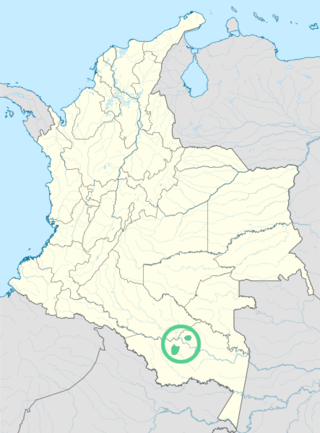| Muinane | |
|---|---|
| Muìnánɨ | |
| Native to | Colombia |
| Region | Puerto Santander, Amazonas; between Caquetá River and Yari River in Caquetá Department |
| Ethnicity | 2,100 (2018) |
| Native speakers | 150 (2007) |
| Language family | ?Bora–Witoto
|
| Language codes | |
| ISO 639-3 | bmr |
| Glottolog | muin1242 |
| ELP | Muinane |
 | |
| This article contains IPA phonetic symbols. Without proper rendering support, you may see question marks, boxes, or other symbols instead of Unicode characters. For an introductory guide on IPA symbols, see Help:IPA. | |
Muinane is an indigenous American language spoken in Colombia.
Classification
Muinane belongs to the Boran language family, along with Bora.
Geographic distribution
Muinane is spoken by 150 people in Colombia along the Upper Cahuinarí river in the Department of Amazonas. There may be some speakers in Peru.
Phonology
Consonants
| Bilabial | Alveolar | Postalveolar/ Palatal |
Velar | Glottal | |
|---|---|---|---|---|---|
| Nasal | m | n | ɲ | ||
| Plosive | p b | t d | tʲ dʲ | k ɡ | ʔ |
| Affricate | tʃ dʒ | ||||
| Fricative | ɸ β | s | ʃ j | x | |
| Trill | r | rʲ |
- Voiceless stops and affricates contrast with their geminate counterparts: tː tʃː tʲː kː.
Vowels
| Front | Central | Back | |
|---|---|---|---|
| High | i | ɨ | u |
| Low | ɛ | a | o |
Tone
There are two tones in Muinane: high and low.
Grammar
Word order in Muinane is generally SOV. Case marking is nominative–accusative.
Vocabulary
Loukotka (1968) lists the following basic vocabulary items for Muinane.
English Muinane one sánótro two minóke head nígai eye adíge tooth ígaino man gáife water negfuáyu fire köxögai sun neʔegbua maize bédya jaguar höku
Writing System
Muinane is written using a Latin alphabet. A chart of symbols with the sounds they represent is as follows:
| Latin | IPA | Latin | IPA | Latin | IPA | Latin | IPA | Latin | IPA | Latin | IPA |
|---|---|---|---|---|---|---|---|---|---|---|---|
| a | /a/ | b | /b/ | c | /k/-/s/ | ch | /tʃ/ | d | /d/ | e | /e/ |
| f | /ɸ/ | g(u) | /ɡ/-/x/ | h | /ʔ/ | i | /i/ | ɨ | /ɨ/ | j | /x/ |
| ll | /dʒ/ | m | /m/ | n | /n/ | ñ | /ɲ/ | o | /o/ | p | /p/ |
| qu | /k/ | r | /r/ | z | /s/ | s | /ʃ/ | t | /t/ | u | /u/ |
| v | /β/ | y | /j/ |
- Palatalized consonants are written using the unpalatalized forms plus y: ty /tʲ/, dy /dʲ/, ry /rʲ/. For the purposes of alphabetization, these are considered sequences of letters.
- Tone is not generally indicated in writing. When it is shown, it is indicated by an acute accent over the vowel: á, é, í, ɨ́, ó, ú.
- The Muinane writing system is based on Spanish orthography. For that reason, the sound /k/ is written as c before a, ɨ, o, and u and as qu before e and i. Likewise, the sound /ɡ/ is written as gu before e and i, and g elsewhere.
References
- ^ Muinane at Ethnologue (25th ed., 2022)

- Cite error: The named reference
Loukotkawas invoked but never defined (see the help page).
Sources
- Aschmann, Richard P. (1993), Proto-Witotoan, Arlington, TX: SIL International, ISBN 0-88312-189-1
- Walton, James P.; Walton, Janice W.; Pakky de Buenaventure, Clementina (1997), Diccionario Bilingüe Muinane-Español/Español-Muinane, Santafé de Bogotá: Editorial Buena Semilla, OCLC 468683910
| Languages of Colombia | |||||||||||||||||
|---|---|---|---|---|---|---|---|---|---|---|---|---|---|---|---|---|---|
| Official languages | |||||||||||||||||
| Indigenous languages |
| ||||||||||||||||
| Creoles/Other | |||||||||||||||||
| Sign languages | |||||||||||||||||